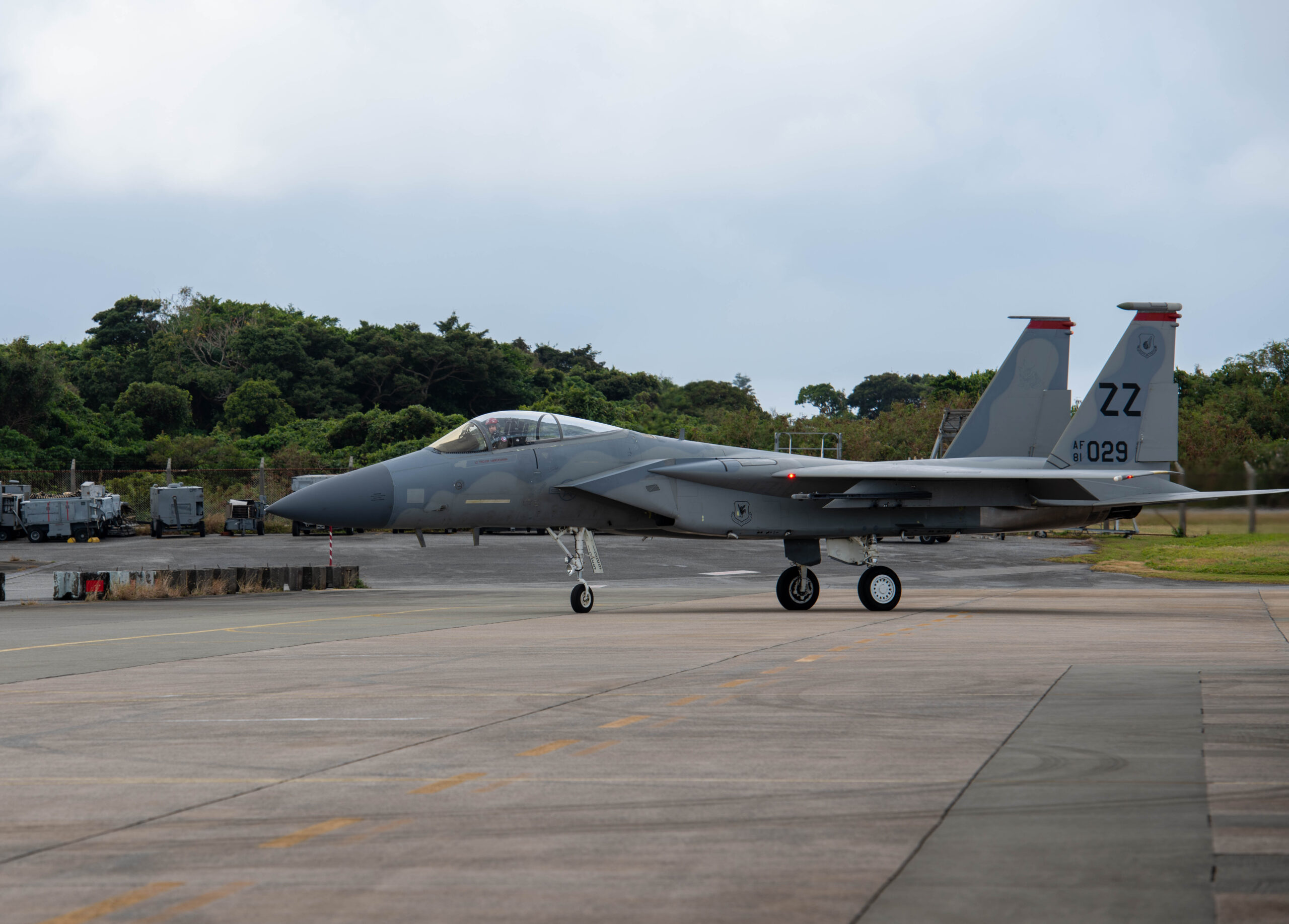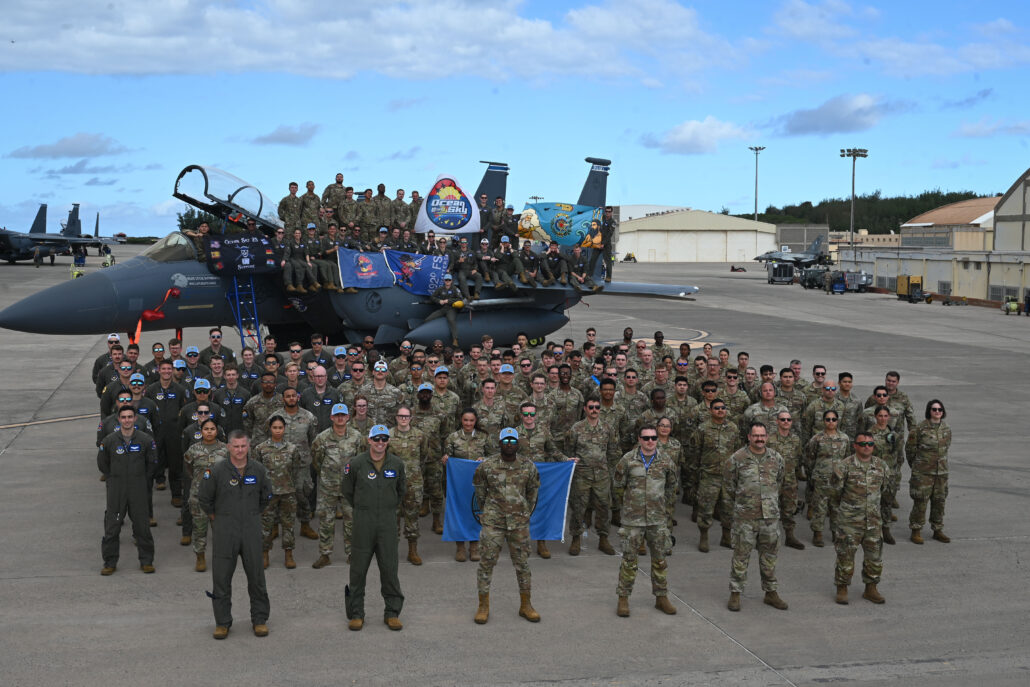On March 26, 2025, the Kadena Air Base announced that the U.S. Air Force has officially retired the F-15C from its active-duty inventory, marking the end of more than four decades of service for the air superiority fighter. The decision, part of a broader effort to modernize U.S. airpower, culminated in the permanent retirement of the F-15C/D Eagle fleet from Kadena. The retirement, carried out through a rotational deployment model, reflects ongoing concerns over maintenance challenges, airframe fatigue, and the need to transition toward modernized fourth-generation and fifth-generation aircraft better suited for the Indo-Pacific’s evolving threat environment.
The move was confirmed on April 9, 2025, by the U.S. Pacific Air Forces (PACAF), which reported that the final permanently assigned F-15C/D Eagles had departed Kadena in late March 2024. This follows an initial announcement in November 2022 that the 18th Wing’s aging fleet of Eagles would be withdrawn due to growing maintenance burdens and airworthiness concerns. Brigadier General David Eaglin, commander of the 18th Wing, emphasized that the decision was not about replacing the F-15C/Ds with a specific aircraft, but rather about maintaining combat capability through a mix of rotational aircraft and a more sustainable force posture. Since the start of the drawdown, Kadena has hosted rotating deployments of F-22A Raptors, F-16CM Fighting Falcons, F-15E Strike Eagles, and F-35A Lightning II fighters to maintain combat readiness.
The phaseout of the F-15C/D from Kadena was influenced by both maintenance considerations and regional security planning. The Eagles, introduced to Okinawa in the early 1980s, have long provided a high-performance air superiority presence on Japan’s southernmost islands, replacing the Vietnam-era F-4 Phantom II. Their permanent deployment was once a cornerstone of U.S. power projection and rapid response capabilities in East Asia. However, many of the aircraft in Kadena’s fleet are among the oldest airframes in the Air Force’s inventory, with more than 40 years of active service, prompting concerns about structural fatigue, avionics obsolescence, and escalating maintenance costs. Rather than invest further in aging fourth-generation fighters, the Air Force has opted to gradually replace their capability with more modern aircraft, many of which offer stealth, sensor fusion, and multirole functionality.
While the Eagles’ departure marks the end of an era, it also raises concerns about a potential capability gap in the Pacific. Kadena previously hosted two permanently assigned fighter squadrons, the 44th and 67th Fighter Squadrons, under the 18th Wing. Their retirement leaves the base without a fixed-wing air superiority force based in Okinawa full-time, as the 44th and 67th Fighter Squadrons are no longer equipped with F-15Cs. Although U.S. officials have stated that the rotational presence of newer aircraft will ensure comparable operational capacity, there have been questions from Japanese officials and U.S. lawmakers about the long-term presence and implications for regional security, especially in light of China’s expanding airpower and missile arsenal. The U.S. Air Force has stated that the rotation model enables force flexibility and maintains mission effectiveness in the Indo-Pacific.
Kadena Air Base was constructed in 1945 by U.S. forces after the Battle of Okinawa, incorporating parts of the pre-existing Yara Hikojo airfield. It quickly evolved into a major U.S. installation supporting various operations throughout the Cold War and post-war Asia-Pacific conflicts. During the Korean War, it served as a launch point for B-29 Superfortress missions. In the Vietnam War era, it hosted F-105 Thunderchiefs and other tactical aircraft. Over the decades, its facilities expanded to include hardened aircraft shelters, surveillance capabilities, and support for bombers, tankers, fighters, and intelligence platforms. Today, Kadena is regarded as the largest and most strategically valuable U.S. Air Force base in the Indo-Pacific.
Currently, Kadena is home to the 18th Wing, the largest combat wing in the U.S. Air Force, composed of multiple squadrons focused on air superiority, aerial refueling, airborne early warning and control, and rescue operations. Aircraft regularly stationed at or rotated through Kadena include the KC-135 Stratotanker, E-3 Sentry AWACS, HH-60G Pave Hawk, and RQ-4 Global Hawk drones. The base supports joint and combined training with Japan’s Self-Defense Forces and plays a role in regional deterrence, logistics, and rapid response scenarios.
Kadena’s geographical location makes it one of the most strategically critical airbases in the U.S. global posture. Located less than 800 kilometers from Taiwan and within reach of the East China Sea, South China Sea, Korean Peninsula, and even mainland China, Kadena provides the U.S. military with rapid reaction capability in a region characterized by contested air and maritime domains. Its proximity to key flashpoints and alliance partners allows the U.S. to execute force projection, joint deterrence with Japan, and power balancing against Chinese regional ambitions. While the departure of F-15Cs alters the force structure at the base, Kadena continues to function as a key hub for force projection and contingency operations.
The F-15C was developed in the 1970s by McDonnell Douglas as an evolution of the original F-15A/B design, itself a direct response to the Soviet MiG-25 Foxbat threat. Designed as a dedicated air superiority fighter, the F-15C retained the Eagle’s powerful twin-engine configuration and large radar cross-section while incorporating critical upgrades such as additional internal fuel capacity, increased weapon load, and improved radar systems. Entering service in 1979, the F-15C formed the backbone of U.S. air dominance during the final decades of the Cold War and continued to do so well into the 21st century, receiving periodic avionics and structural upgrades to extend its service life. In the Fiscal Year 98, the unit cost of a F-15C was reported to be around $29.9 million, the same as the F-15D variant.
In terms of operational history, the F-15C is credited with achieving over 100 confirmed dogfight victories with no reported losses in such air-to-air engagements. Most of these kills were achieved during Operation Desert Storm in 1991, when the F-15C dominated Iraqi aircraft, including MiG-29 Fulcrums and Mirage F1s. The aircraft also saw combat over the Balkans, enforcing no-fly zones in Bosnia and Kosovo, and more recently supported air patrols over the Persian Gulf and missions related to the campaign against the Islamic State. Its high speed, long range, powerful radar, and missile loadout enabled U.S. pilots to engage and destroy enemy aircraft before they could mount a threat.
The F-15C is powered by two Pratt & Whitney F100-PW-220 or F100-PW-100 afterburning turbofan engines, each producing up to 23,770 pounds of thrust. It has a maximum speed of Mach 2.5 (approximately 3,000 km/h) at altitude and a service ceiling above 18,000 meters. Its unrefueled combat radius is roughly 1,000 kilometers, though this can be extended via conformal fuel tanks or aerial refueling. The standard armament of the F-15C Eagle includes an M61A1 20mm Gatling gun, as well as a combination of AIM-9 Sidewinder infrared-guided missiles and AIM-120 AMRAAM radar-guided missiles for air-to-air combat. Many aircraft were later retrofitted with the APG-63(V)3 AESA radar, enabling long-range target acquisition, synthetic aperture radar mapping, and enhanced jamming resistance.
The F-15C’s airframe design focuses on a high thrust-to-weight ratio, large wing area, and low wing loading, enabling it to maintain maneuverability even at high speeds and altitudes. It can perform 9 g turns and simultaneously engage multiple targets using radar-guided missiles. The aircraft also benefited from upgrades like the Joint Helmet-Mounted Cueing System (JHMCS), which allowed pilots to aim weapons through head movement, significantly enhancing close-combat effectiveness. However, it lacks stealth features and is increasingly vulnerable to advanced radar-guided surface-to-air missile systems and fifth-generation fighters, limiting its viability in high-threat environments.
By the late 2010s, the Air Force began assessing the feasibility of maintaining the F-15C fleet versus recapitalizing with modern aircraft. Aging wiring, airframe stress, and avionics obsolescence led to high maintenance costs and reduced mission-capable rates. While still effective in uncontested airspace, the F-15C was no longer considered survivable in near-peer conflict scenarios, particularly against Russian S-400 systems or Chinese J-20 fighters. This realization contributed to the U.S. Air Force’s decision to retire the aircraft from front-line bases and prioritize newer platforms.
The F-15EX Eagle II, developed by Boeing, is the designated successor to the F-15C. While retaining the aerodynamic design of its predecessor, the EX features fly-by-wire controls, the APG-82(V)1 AESA radar, and a digital open mission systems architecture. It is equipped with the EPAWSS self-protection suite and can carry a larger payload, up to 22 air-to-air missiles or a mix of air-to-ground munitions. The F-15EX can also integrate hypersonic weapons like the AGM-183 ARRW and has a projected service life of 20,000 flight hours. Though not a stealth aircraft, its unmatched payload, sensor fusion, and relatively low operating cost make it a transitional solution pending the development of sixth-generation air dominance platforms, such as the Next Generation Air Dominance (NGAD) program.



